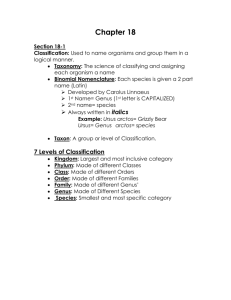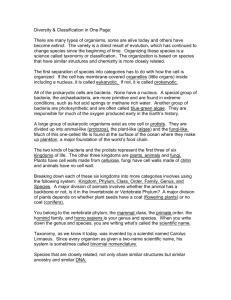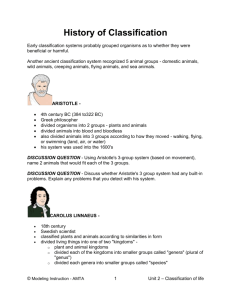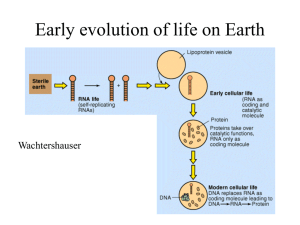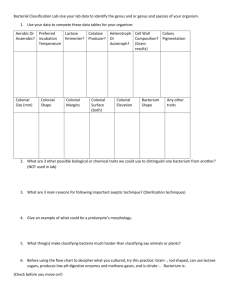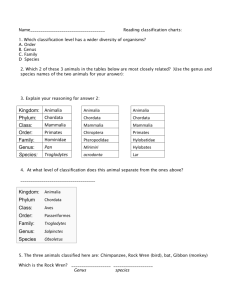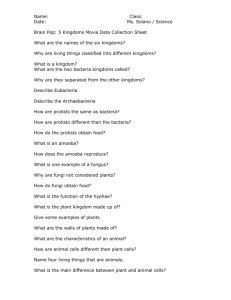The Classification of Living Things
advertisement
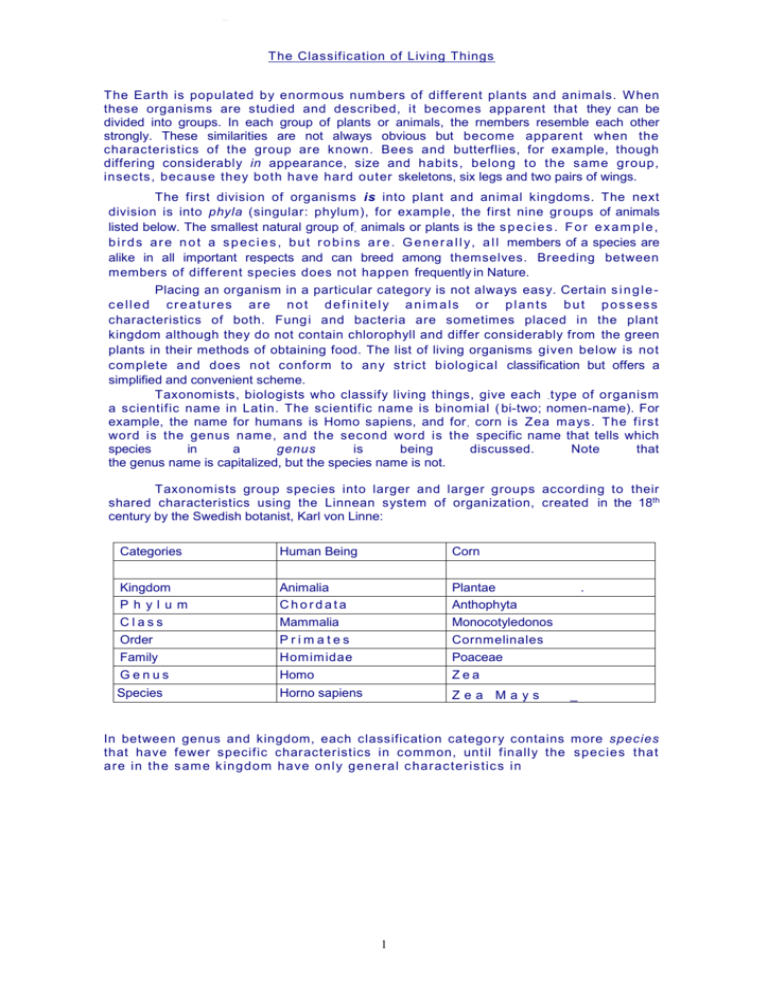
Ala The Classification of Living Things The Earth is populated by enormous numbers of different plants and animals. W hen these organisms are studied and described, it becomes apparent that they can be divided into groups. In each group of plants or animals, the rnembers resemble each other strongly. These similarities are not always obvious but become apparent when the characteristics of the group are known. Bees and butterflies, for example, though differing considerably in appearance, size and habits, belong to the same group, insects, because they both have hard outer skeletons, six legs and two pairs of wings. The first division of organisms is into plant and animal kingdoms. The next division is into phyla (singular: phylum), for example, the first nine gr oups of animals listed below. The smallest natural group of , animals or plants is the s p e c i e s . F o r e x a m p l e , b i r d s a r e n o t a s p e c i e s , b u t r o b i n s a r e . G e n e r a l l y , a l l members of a species are alike in all important respects and can breed among themselves. Breeding between members of different species does not happen frequently in Nature. Placing an organism in a particular category is not always easy. Certain s i n g l e celled creatures are not definitely anim als or plants but possess characteristics of both. Fung i and bacteria are sometimes placed in the plant kingdom although they do not contain chlorophyll and differ considerably from the green plants in their methods of obtaining food. The list of living organisms given below is not complete and does not conform to any strict biological classification but offers a simplified and convenient scheme. Taxonomists, biologists who classify living things, give each . type of organism a scientific name in Latin. The scientific name is binomial ( bi-two; nomen-name). For example, the name for humans is Homo sapiens, and for , corn is Zea mays. The first word is the genus name, and the second word is the specific name that tells which species in a genus is being discussed. Note that the genus name is capitalized, but the species name is not. Taxonomists group species into larger and larger groups according to their shared characteristics using the Linnean system of organization, created in the 18th century by the Swedish botanist, Karl von Linne: Categories Human Being Corn Kingdom Ph ylum Class Order Family Animalia Chordata Mammalia Primates Homimidae Plantae Anthophyta Monocotyledonos Cornmelinales Poaceae Genus Homo Zea Species Horno sapiens Zea Mays . _ In between genus and kingdom, each classification catego ry contains more species that have fewer specific characteristics in common, until finally the s pec ies that are in th e s am e k ingdom have on l y gen eral c harac teris tic s in 1 common. For example, all species in the genus Zea look pretty much the same, t h a t i s , l i k e c o r n p l a n t s , w h i l e t h o s e s p e c i e s i n t h e p l a n t k i n g d o m a r e q u i t e different, as when we compare grass to trees. Taxonomists disagree about the number of kingdoms there are today, however, recognize the 5 kingdoms that are listed below. The five kingdom system: This classification system organizes the diversity of life into the kingdom Monera, which comprises all prokaryotes, and four kingdoms of eukaryotes: Protoctista, Plantae, Fungi, and Animalia. Kingdoms of life: Monera Small, simple singlecell(sometimes chains or mats) Absorb food (some photosynthetic) Bacteria including cyanobacteria Protista Large, complex single cell (sometimes chains or colonies) All types Protozoans, algae of various types Fungi Multicellular filamentous form with specialized complex cells Absorb food Molds and mushrooms Plantae Multicellular form with specialized complex cells Photosynthesize food Mosses, ferns, wood and nonwood flowering plants Animalia Multicellular form with specialized complex cells Ingest food Sponges, worms, insects, fish, amphibians, reptiles, birds, and mammals Look at the vocabulary exercises that follow: Text 2 : The Classification of Living Things Exercise 1: Match the terms with their definition. 1.eucaryote a)a free-living, nonphotosynthetic, single-celled, motile eukaryotic organism. Most of them live by feeding on other organisms, as predators or as parasites. 2. procaryote b) the grasses: chiefly herbaceous but some woody plants including cereals; bamboo; reeds; sugar cane. 3.protozoan c) living organism composed of one or more cells with a distinct nucleus and cytoplasm. Includes plants, animals, fungi, and protozoa; excludes bacteria 4. poaceae d) An order of monocotyledonous herbs 5.commelinales e)the basic unit from which living organisms are made, consisting of an aqueous solution of organic molecules enclosed by a membrane. 6.cell f) type of living cell distinguished by the absence of a distinct nucleus. Bacterium 2 Exercise 2: Read the theoretical part on Latin or Greek plurals and then find the plurals of the words in the list; use a dictionary if needed. Theory: There are a lot of nouns in English of Latin or Greek origin, which often end in –us, -a, um, -on. The plural forms of these nouns can sometimes cause difficulty. a)some especially scientific terms have kept their original singular and plural forms: e.g. bacillus/ -i b) many, especially those in general use, now only have a regular English plural form: e.g. arena-arenas, circuscircuses, electron-electrons c) some have alternative plural forms, which are both acceptable. The Latin form is more formal: e.g. focus-foci, formula-formulas/formulae, spectrum-spectrums/spectra d) there is uncertainty with some nouns as to whether they are singular or plural: e.g. This data is correct. or These data are correct.; medium-media, media Now, write the plurals of the words: embryo virus maximum vacuum alumin(i)um atom quantum silicon focus genus fetus fungus phylum nucleus radius memorandum optimum equilibrium minimum bacterium Exercise 3: Find the synonyms of the following words: obtain considerably breed convenient obvious nomenclature Exercise 4: Fill in the gaps with the provided words; one is redundant Bacteria, optimum, cytoplasm, rod-shaped, wall, reproduce, essentials, encloses, evolve, matrix, cervix Among present-day cells,1)……… have the simplest structure and come closest to showing us life stripped down to its 2)……...... . They are typically spherical, 3)………., or spiral cells, a few micrometers long. They often have a tough protective coat, called a cell 4) ……., beneath which a plasma membrane 5) ………. a single compartment containing the 6) …………, including DNA. In the electron microscope this cell interior typically appears as a 7) ………. of varying texture without any obvious organised internal structure. Bacteria typically are small and 8) ………… quickly by dividing in two. Under 9) ………….. conditions, when food is plentiful, a bacterium can duplicate itself in this way in as little as 20 minutes. Because of their large numbers and rapid growth rates, populations of bacteria can 10)…………. fast, rapidly acquiring the ability to use a new food source or to resist by being killed by a new antibiotic. 3
